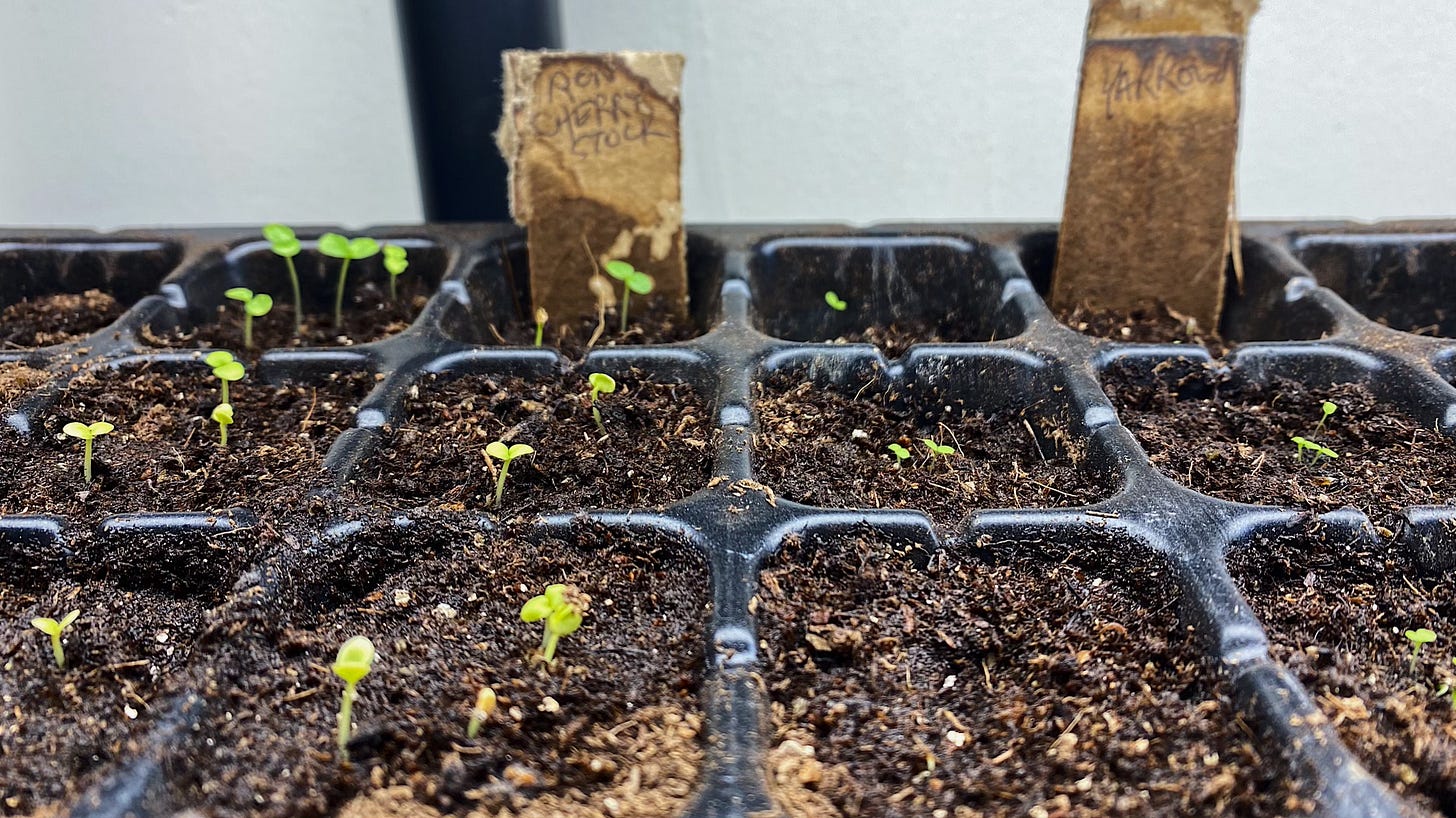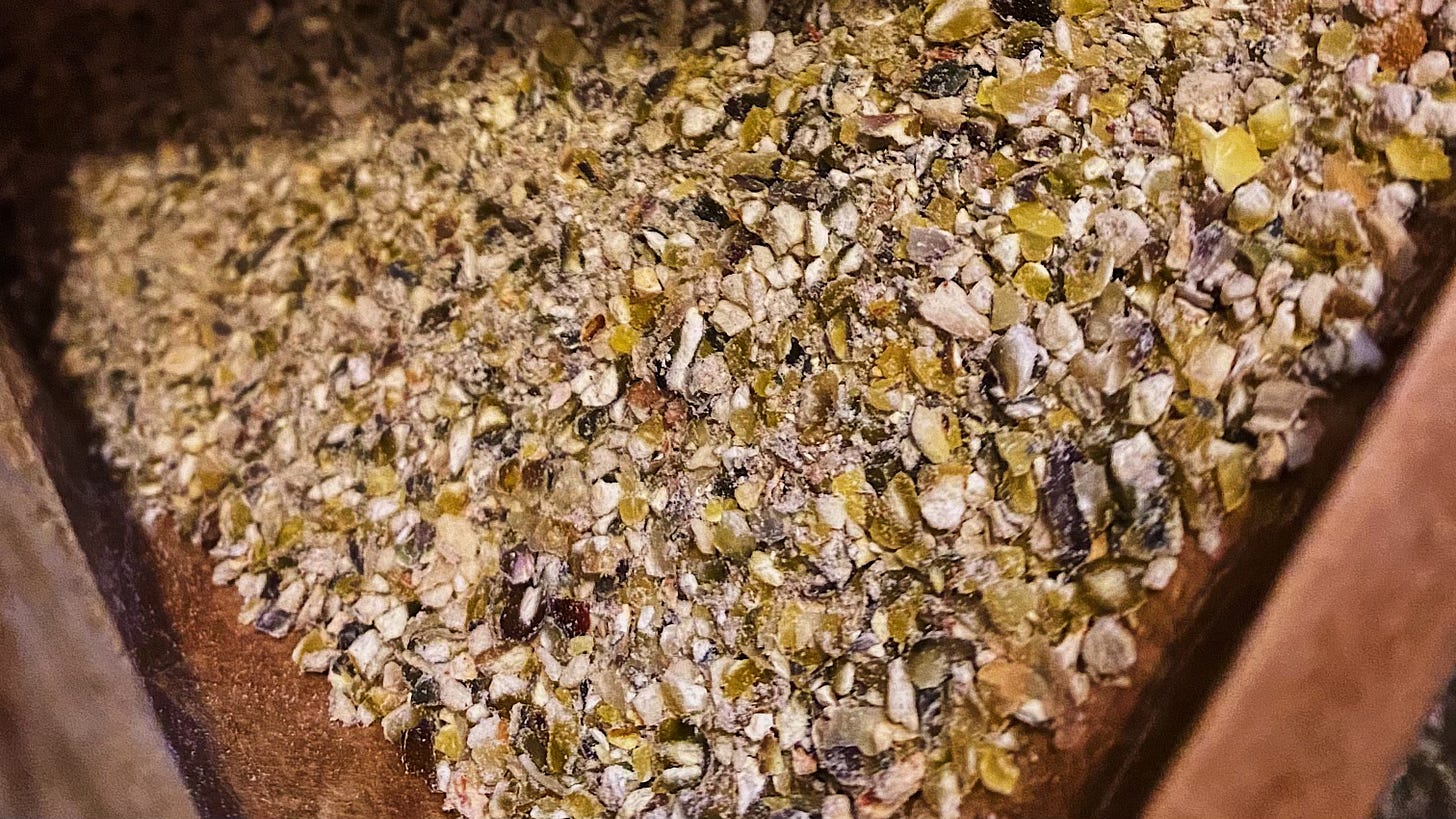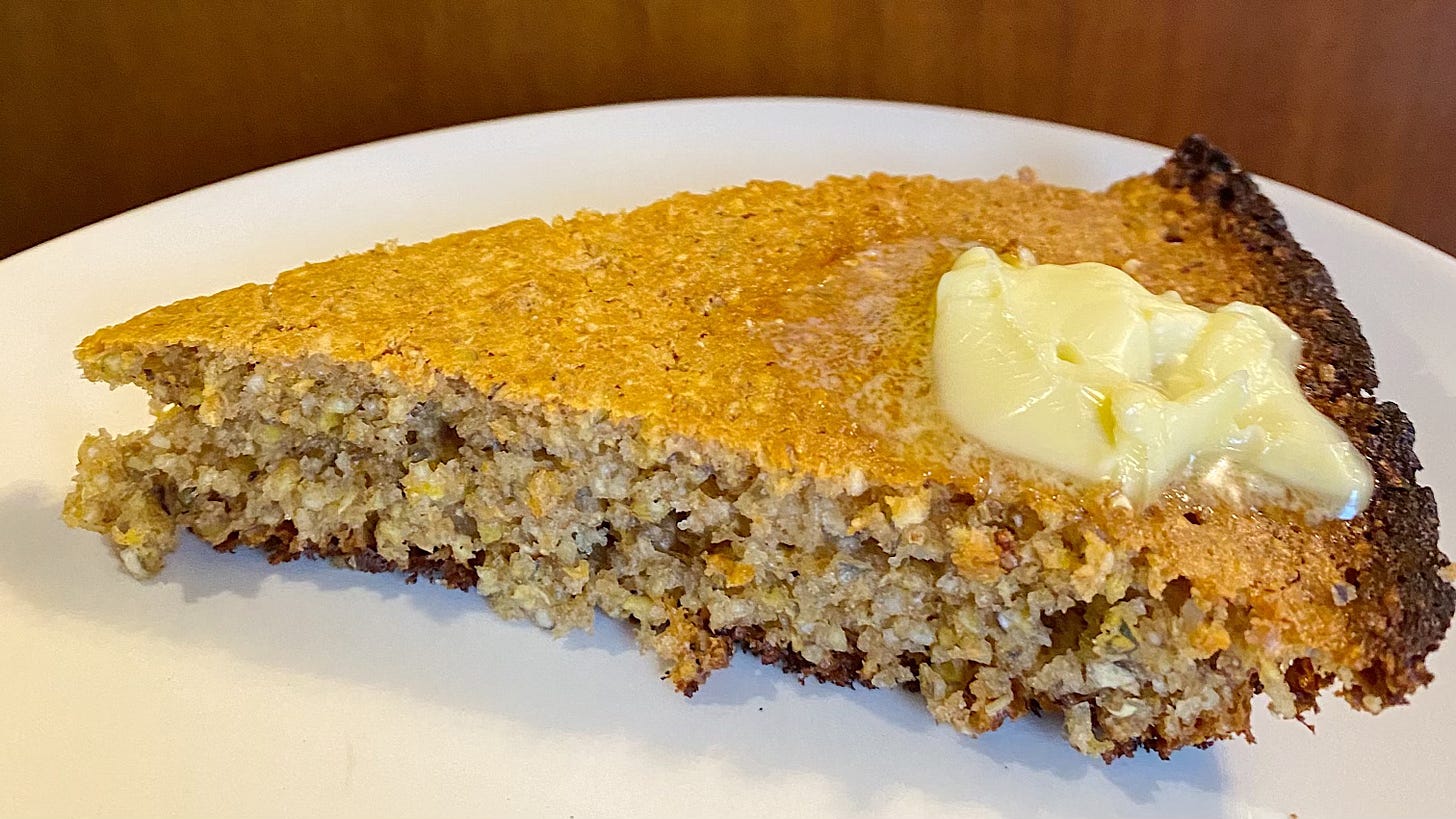How Long, O Lord?
Some fragmented thoughts on an ancient prayer of supplication, a modern song of encouragement, germinating seeds, and cornbread
Lent VI
Grand Rapids, Michigan
Hello, dear reader.
After Atlanta, I had some words, not all of them publishable. After Boulder—yet another massacre, yet another grievous episode of gun violence—I had nothing of my own, just the ancients’ prayers. So I tweeted, “How long, O Lord?”
Some folks on Twitter found this irritating and trite. I see how they might read the line that way. To my eyes and ears, though, the psalmist’s words are more than a helpless, spiritualized shrug or a throwing-up of the proverbial hands. Instead, they’re an act of holy surrender. To wholeheartedly ask, “How long, O Lord?” can help us name a bleak reality and then seek what God might have to say next.
This pattern of prayer extends well beyond the psalms. The Book of Habakkuk begins with the prophet asking God, “O Lord, how long shall I cry for help... Why do you make me see wrongdoing and look at trouble?” What follows is God’s indictment of human arrogance and greed, the objectification of bodies and the commodification of creation, widespread killing and the desecration of the earth. It all feels frighteningly contemporary, as if humanity has not changed much over the millennia.

I’ve been drawn to the “How long, O Lord?” prayers for years, though for much pettier, more self-serving reasons. In eighth grade, after a disastrous camping trip, I lost the one close friend I’d had. More than anything, I wanted some cool kid at school—really, I’d have settled for any marginally acceptable kid—to invite me over. How long, O Lord, until someone wants to be my friend? No answers seemed forthcoming, so I’d slump and pout on our family-room couch, a pale-peach leather sectional that was useless for soaking up my tears; they just rolled right off.
In that season, the most annoying person in my life was unquestionably my mom. As she passed me on her way to the laundry room, she’d say, “Well, you should pray. Jesus is your friend.” My mom’s Jesus is a deity of constant companionship for whom no matter is too trivial. Sometimes I call him “Jesus of the parking lot,” because whenever we drove into the supermarket parking lot, she’d ask us to ask Jesus for a good spot, as if He’d send the Holy Spirit to be our personal valet.
On some level, I envied my mom’s intimate confidence in this Jesus. But I couldn’t let on. Instead, I yelled at her: “Jesus isn’t coming over to hang out with me!” Jesus didn’t play ping pong. Jesus didn’t laugh at my jokes. Jesus had no interest in sharing my fried rice. All of my mom’s God talk, all the Jesus chatter, felt like platitudes, because I didn’t see much evidence of Jesus’s friendship at all.
Looking back, I’m embarrassed at how I saw God, at how I envisioned Jesus—as divine service provider, there to ease my life in exchange for the occasional, halfheartedly sung praise song and a dollar a week in the offering plate. What had the Cross been for, if not to improve my dire Super Mario skills? Why had Christ been resurrected, if not to offer me the abundant life in the form of a Lego-loving playmate?
It never occurred to me then: What if I could be a friend to someone else who needed one? It wasn’t until well into adulthood that I began to realize that the answer to the question, “How long, O Lord?” might be: “Good question, kid. Whenever you’re ready.”
Perhaps prayers like these enable us to work through emotion—confusion, frustration, anger, angst—so that we can find the more generative feelings on the other side. To lament, we have to name what ails us. We have to put words to the pain, suffering, and longing. We have to see things as they are, not as we’d wish them to be. We have to entrust reality, with all its attendant grief, to One who is capable of the transformation that we feel is beyond us. Then, maybe, we’ll be ready for the next part of the work.
By the end of his short book, Habakkuk sounds like a man renewed, proclaiming: “God, the Lord is my strength; God makes my feet like the feet of a deer, and makes me tread upon the heights.” Such prayers can move us, preparing us for what God has to say next. The transformation might need to happen within us, our ears perked, so that we can understand when God responds, as to Habakkuk, by saying: Indeed, what’s next? Look, there is another way. What are you going to do about it?
If Lent is about preparation, about planting, perhaps “How long...” prayers are a form of weeding, clearing the detritus and debris from the soil so that we can begin to sow new seed. Maybe they offer us a path toward active participation. Maybe they remind us that we’re not just passive bystanders but that we can also be messengers of justice, witnesses to goodness, even cultivators of hope.
How long, O Lord,
until we turn from gods of our own making,
until we turn toward the good,
until we turn to God?
How long, O Lord,
until we honor all of humanity,
until we cherish all of creation,
until we accept the invitation not to destroy but to cultivate,
until we join in the chorus crying out for abundant life?
How long, O Lord,
until we love our neighbor,
until we love our neighbor as ourselves,
until we love our enemies,
until we love even the enemies within,
until we love ourselves?
How long, O Lord
until we recognize what power we have,
until we realize the gifts we’ve been given,
until we summon our tender strength and our holy courage,
until we use our voices for justice and healing?
How long, O Lord,
until we surrender to the call on our lives,
until we surrender to hope we’ve been given,
until we surrender to love?
What I’m Listening to: Several years ago, my friend Noah sent me a song, “Your Labor Is Not in Vain,” by the collective Porter’s Gate. It offers a stirring antidote to any who might be asking: “How long, O Lord, before we begin to see some fruit for all the planting we’ve done?” I’ve returned to this song again and again to renew my hope.
What I’m Growing: I’m behind schedule—the peppers should have gone into the trays already. But I did plant lavender, lemon balm, and snapdragon last week. And the iron-cherry stock and the yarrow have begun to germinate. You don’t want to know how much time I spend sitting in front of those trays, watching for signs of life unfurling. There’s something miraculous about how, in the darkness of the soil, something awakens in these seeds, suggesting that it’s time for them to unfold to something new.
What I’m Cooking: On Wednesday, I made cornbread. I rarely ate cornbread growing up; I don’t think my mom’s kitchen ever produced any version of it. My only early exposure came in the form of sickly sweet supermarket corn muffins or the stuff out of the Jiffy box. Only later did I encounter versions that were less cloying, more crumbly than dense, and less cake-like; as Tristan reminded me the other day, the second half of the word “cornbread” is “bread,” not “cake.”
The corn for the cornbread was Oaxacan green corn, a variety that has been cultivated for millennia by the Zapotec people in what is now southern Mexico. Corn is sacred in Zapotec culture; one legend I read said that corn is a manifestation of the divine, and that the first humans were made from masa, just like the tortillas that are a Zapotec staple. Higher in starch and lower in sugar than many commercial varieties, Oaxacan green is nutty and earthy. Turns out it makes great cornbread—rich, with layers of savory flavor and rustic crunch, because the cornmeal I used was coarse-ground.
My Oaxacan green corn was grown on a farm in Tehachapi, California, 100 miles from Los Angeles, where farmers Alex Weiser and Sherry Mandell are cultivating heirloom grains. Their operation, the Tehachapi Heritage Grain Project, sprang from a question asked by Glen Roberts, of Anson Mills in South Carolina, who, during a visit to the farm, spotted wild rye growing and asked: “Why aren’t you growing grain?”
They started off with barley, some rye that Roberts gave them, and Sonora wheat—a variety that traveled up the California coast with the Spanish missionaries. They’ve since added more wheat—Rouge de Bordeaux, an old French type; Red Fife, from Ontario—as well as the Oaxacan green dent corn and Nothstine dent, an heirloom from Michigan. What these varieties have in common is that they nourish not just the humans who eat them but also the soil in which they’re grown. “We’re trying to bring back flavor and introduce varietals back into our food system so that we’re not this monochromatic landscape of white flour,” Mandell told me. “But we’re really also trying to think about farming in a holistic manner, to help the land. These varietals have a really beautiful root system that naturally sequesters carbon. In California, water is a luxury too. So we’re trying to maintain a really good biosphere, keep the water and the carbon in the soil, and create healthy, loamy soil. And that creates a really beautiful product.”
When I’m eating good bread or excellent grits, I’m not really thinking about the soil—and Mandell gets that. She lets the product do the education. “I try not to beat people over the head with the environmental stuff. The flavor, I think, is the thing,” she said. “When you eat something that is, like, God, I’ve never had something that good, you ask, Why is that? Then you realize that it’s about good farming—and you want to support those farmers. You want to bring that into your home and to your family.”
One day at the farmers’ market early in the pandemic, she was chatting with a shopper who was delighted to find flour at Mandell’s stand, since supermarkets were then running short. She said, “I had no idea flour was grown!” “Did they think it was just something manmade? I guess if they really thought about it, they would understand it has to be grown,” Mandell told me. “But they probably never had to put two and two together. They were just mindlessly buying off the shelf until it wasn’t there.”
The Tehachapi Heirloom Grain Project sells most of what it grows at farmers’ markets and to chefs in Southern California. It’s also partnering with the Blinking Own Distillery in Santa Ana to make a wild rye whiskey, which is now resting in barrels. And it sends some corn every week to Kernel of Truth Organics in East L.A., which nixtamalizes it to make tortillas. Though I managed to cajole Mandell into selling and shipping me some flour and cornmeal, “we’re not really selling online,” she said. “That’s Tehachapi 2.0. If I can figure out how to survive this pandemic financially, we can pivot to bring high-quality, delicious, healthy whole grains to people all over and get them to see the beauty in supporting local, small farmers.”
The pandemic has been tough on small farming operations like Mandell’s, which have been battered by both labor shortages and constantly shifting market dynamics. Early one recent morning, she had to decide whether to harvest a field of barley—and she just didn’t have the money to pay someone do it. She had to let it go. She looked around her kitchen. She had two Reed avocados and some fresh tortillas made with Tehachapi’s corn. “I just fried the tortillas and made chips and sat there with Maldon salt, and I had a guacamole cry-fest at six in the morning,” she says. “It took me right back to childhood.” She laughingly compared the flavor to that of a Frito, except with less processing, more history, and much more goodness for the earth. “That chip was so corn-forward. So corny! The only thing I was missing was the shot of tequila.”
Skillet cornbread: Preheat the oven to 400 degrees F. Pop a 10- or 12-inch cast-iron pan in to preheat too, with 4 ounces (half a cup) of butter. In a big bowl, mix together a cup and a half of cornmeal (medium- or coarse-ground for a more rustic crumb), half a cup of flour, one tablespoon of baking powder, and a teaspoon of salt. In another bowl, whisk together a cup of whole milk, an egg, and a quarter-cup of honey (use up to half a cup if you prefer sweeter cornbread). Carefully take the hot cast-iron pan out of the oven, and pour the melted butter into the milk/egg/honey bowl. Mix well. Then pour the liquid ingredients into the bowl with the dry, and mix until just combined. Pour the batter into the hot pan and bake for about 20 minutes. (I usually go 22. We like our cornbread a bit darker around the edges.)
The Tehachapi Heirloom Grain Project is one of the honorees in this year’s Global Vision Awards, a package I reported and wrote for Travel+Leisure magazine.
I’ve been writing for Travel+Leisure for several years, but I only became an editor-at-large last fall—and this is my first cover story for the magazine. I’m grateful for my editor in chief, Jacqui Gifford, who has always believed that travel writing should do more than highlight the latest spas and the most luxurious hotels. In 2015, she sent me to my beloved Hong Kong, where I wrote about the territory through the eyes of young pro-democracy activists. When I profiled Oakland, California, in 2016, I got to wrestle with questions of change and gentrification. And in this year’s Global Vision Awards, we spotlight topics including diversity and inclusion in storytelling, making travel accessible to disabled people, and projects raising awareness of the planet’s fragile ecosystems. You can read the rest of Travel+Leisure’s Global Vision Awards coverage here. Or pick up a copy of the April issue at a bookstore near you!
That’s all I’ve got for you this week. I’m always glad to hear what’s on your heart and mind, so please leave a comment and share your thoughts and reflections. And as ever, I’m so glad we can stumble through all this together, and I’ll try to write again soon.
Best,
Jeff







This was such a blessing to me on this day. I appreciate your wisdom and am thankful for your words
Your writings are always such a gift to me. Thank you for the work you do, for opening your heart, mind & life to us. And tell Tristan that there is cornbread & corncake...and both are fabulous!!! 😉